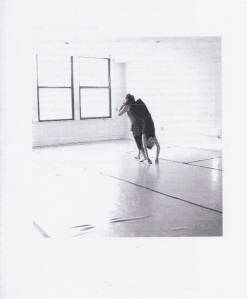Carrie Olivia Adams, Grapple. Ottawa: above/ground press, 2016.
abovegroundpress.blogspot.comIt is notoriously difficult to capture one art form in another; can one do more than search for clumsy equivalents, fractured reflections? And yet when I read Carrie Olivia Adams’ Grapple for the first time, it was if I could see the movement and struggle of bodies in my mind. Not only the words themselves but the placement of the lines, fragments across a wide page, evoked extension and constriction, stillness and action.My first reading was without benefit of the “Notes on the Composition” which comes after the eight-page poem. I did have the image on the cover, and two inside, to know this was a dance in words. And the epigraph by Nawal El Saadawi told me that the poem was about movement and passivity, surrender and resistance. But it was only upon reading the notes that I understood the poem to actually be a text that had accompanied a dance performance–a performance inspired (if that’s the right term) by the arrest of “a young African American man during a protest as part of Moral Mondays Illinois in Chicago in November 2015.”The poem begins with two definitions of the title–“to stop the progress or movement of / (something)” and “to attract and hold the attention of / (someone or something).” This apparent contradiction, or mirror-imaging, is carried on throughout, with “strength” linked to “vulnerability” and going “limp” being an “act of resistance / …an act of / strength”. There is a particularly telling moment whenWe cannot see your face you cannot see ours pressedBut we are so closeThese words seem to me both powerful, frightening, and almost beautiful. On the poem’s next page, however, the poet becomes somewhat less nimble, writing in true, if sloganeering fashion, of a city that “forgets / the backs on which it is built”. But then the poet becomes more suggestive again:Tell us again how you knowhow you submerged us
how we re-wrote the movement of sidewalk and street
how it bent up to meet usThese words were spoken to a dance created by Chicago choreographers Jamie Corliss and Lydia Feuerhelm, who were also the performers. According to the “Notes,” the dance and the words were intended to “work with and against each other,” echoing the tension within the poem itself. I certainly would have liked to see this performance in which “intimacy and aggression overlap” but the poem works well on its own, especially with the accompanying photographs. It is a work that, while for the most part not allowing its political purpose to diminish its artistry, never forgets that purpose.
Tuesday, December 6, 2016
Cary Fagan reviews Carrie Olivia Adam's Grapple (2016)
Toronto writer Cary Fagan was good enough to provide the first review for Carrie Olivia Adam's Grapple (2016) over at his new Bodies and Words. Thanks much! You can see Fagan's post here. As he writes:
Subscribe to:
Post Comments (Atom)

















No comments:
Post a Comment